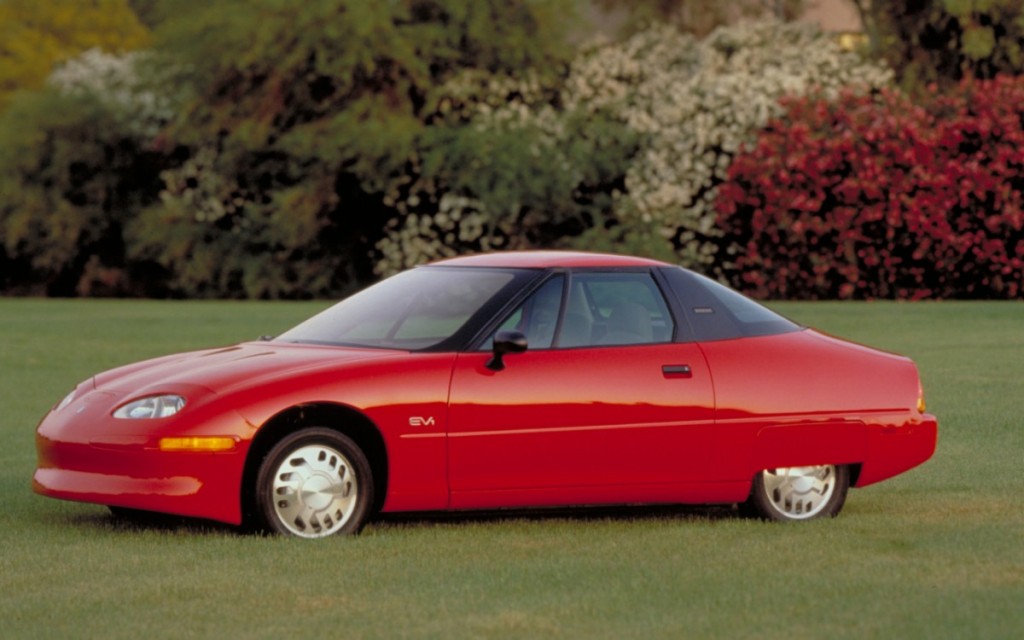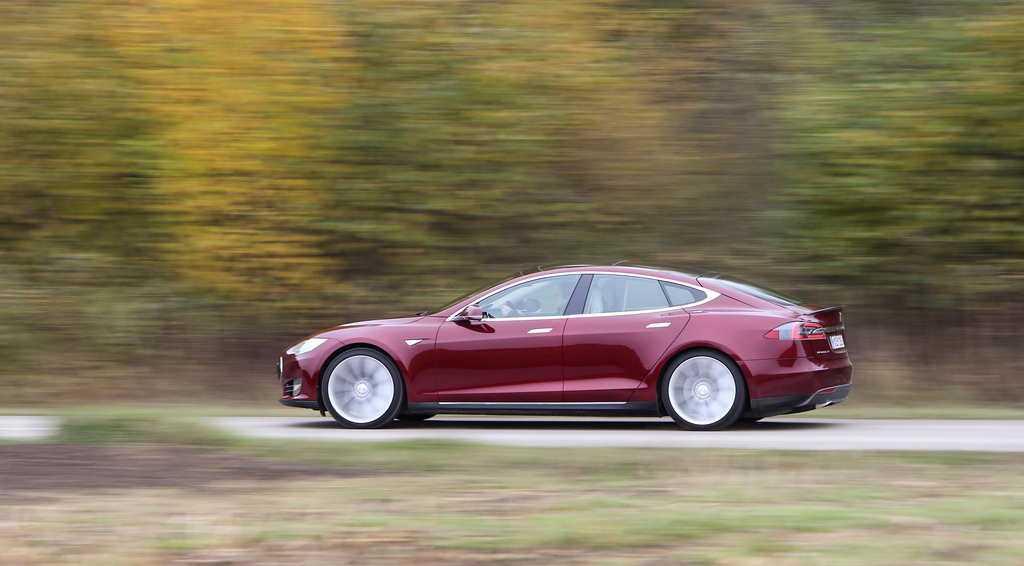
1996 General Motors EV1
Twenty years ago today, the very first GM EV1 electric cars were delivered to 40 lessees in California in a blaze of publicity.
Since then, plug-in electric vehicles have seen more than their share of ups and downs.
That first EV1 was a high-tech two-seater created specifically to meet California's then-current zero-emission vehicle rules, intended to set the state on a path toward radically lowering vehicle emissions.
DON'T MISS: GM loses $9K on each Chevy Bolt EV to become major player in electric cars: report
But those ZEV rules were ultimately overturned by the state after automakers lobbied successfully with the argument that electric cars were too expensive to build, that buyers didn't want them, and that there wasn't adequate public charging infrastructure.
Does this sound familiar?
Just last week, Ford CEO Mark Fields told reporters the company would lobby the incoming Trump administration to delay, modify, or repeal stricter fuel-economy standards—and commented that there was no market for electric cars or hybrids.

2017 Chevrolet Bolt EV, road test, California coastline, Sep 2016
Ford's current lineup of hybrids is solidly in second place among U.S. hybrid sales after various Toyota hybrids—the Ford Fusion Energi plug-in hybrid sedan had its best sales month ever in November—but the company's efforts in battery-electric cars have been grudging and uncompetitive.
Until an updated 2017 Focus Electric was announced, that battery-electric model had the lowest range (73 miles) of any compact electric hatchback on sale and sold solely at compliance-car levels.
But while Ford has always been an also-ran in electric cars, the arrival of the Tesla Model S reset a lot of expectations among consumers about just what an electric car could be.
TODAY'S NEWS: Ford will ask Trump to cut fuel-economy rules, CEO says; 'no demand' for hybrid, electric cars
It also alarmed other makers, General Motors among them, sufficiently that they took a closer look at the potential for building cars with high-capacity battery packs made of the latest lithium-ion cells.
Now every major automaker is planning to offer higher volumes of electric cars by 2020—even Toyota, whose strong belief in the superiority of hydrogen over electricity as a way to power cars made it the last major holdout.
So where do electric cars stand today, 20 years after the EV1 emerged into private hands?

2012 Tesla Model S
(1) The world now takes climate change seriously, meaning increasingly tough limits on emissions.
Even if president-elect Trump doesn't accept the scientific consensus on climate change, which he has called "bullshit" that was created by the Chinese to hurt U.S. industry, the rest of the world is moving toward reducing carbon emissions in every sector—China not least among countries.
However the laws are written, zero-emission vehicles will be increasingly favored by regulators.
CHECK OUT: Audi e-tron vs Jaguar I-Pace vs Mercedes EQ: electric luxury SUVs compared
And they are far more likely to be plug-in electric cars than hydrogen fuel-cell vehicles.
(2) Range matters more than many carmakers understood.
In Europe and Asia, electric cars with ranges lower than 100 miles are practical because there's a clean, reliable, frequent, pervasive mass-transit alternative for many longer trips.
The U.S. has no such thing, so individual vehicles have to serve all possible travel needs short of the distances only an airplane can cover—so less than something like 150 to 200 miles of range is simply a deal-breaker for many buyers.
People don't drive as many miles as they think they do, surveys show, but confidence in a vehicle's ability to meet anticipated needs—taking a sick kid to a hospital 40 miles away at 1 am—is an absolute requirement.
Tesla understood this from the outset; it's never sold a car with less than 200 miles of range. Belatedly, other makers are catching on.

1996 General Motors EV1
(3) Once they drive them, consumers really like electric vehicles as cars.
They're simply a better way to drive: smoother, quieter, and calmer.
The challenge is simply getting buyers to give them a try—or as it's known among advocates, the "butts in seats" problem.
Some automakers are addressing this by offering serious potential buyers the loan of an electric car for a full day or a weekend or even a week.
Advocates provide test drives, from letting a neighbor or coworker drive their own car to more formalized and broader events like National Drive Electric Week.
(4) Consumers remain cautious, and understandably so.
An automobile is the second-priciest item a household generally buys, after the house (or apartment) itself.
That purchase generally only happens every three to seven years, and buyers need confidence that the new vehicle will be utterly reliable, meet all their anticipated needs, and generally not have to be thought about much during its life.
Early adopters aside, that means that attitudes toward a radical new technology like electric cars generally fall into a category you might dub, "Let the other guy test it out first and see how it works, and then I'll think about it next time."
(5) Automakers now understand that electric cars are real and are coming; they're just not sure when they'll be profitable.
Any auto company has to make enough profit on its total vehicle lineup not only to cover the marginal costs of building and selling a car, but also investing in future products.
There's much debate over whether Tesla is profitable on a per-vehicle basis (and this site doesn't do financial analysis, so we won't debate that here).
There is almost no debate that Tesla, thus far, hasn't had a profitable year in more than a decade of existence, and continues to require new capital to fund its aggressive expansion plans.
Even at a cell cost of $145 per kilowatt-hour on launch, as confirmed by GM product chief Mark Reuss, the 2017 Chevy Bolt EV allegedly costs the company $9,000 more to make than it sells for, according to a report this weekend.
That's not unusual; Toyota too lost money for almost a decade on its hybrid-electric vehicle programs. But it now supplies 50 percent of all the hybrids sold globally, and they are reportedly profitable for the company.
Lithium-ion cells costs historically fall at 7 percent a year, so sometime in the 2020s—the debates over when are endless—battery-electric cars with 200 miles of range should be priced within spitting distance of their gasoline counterparts in many segments.
Those gasoline cars may also likely cost more in future years than they do now, with added technology to meet higher fuel-efficiency rules and lower emission limits.

1996 General Motors EV1
(6) Unexpected stuff changes the picture.
In 2005, while the company was still in stealth mode, no one in the auto industry foresaw the impact of a company like Tesla Motors. And electric cars, denigrated as golf carts for nerds, were at a nadir.
Even in 2010, when it was struggling to sell small numbers of electric Roadsters, much of the auto press denigrated, sneered at, and otherwise ridiculed the arrogant startup engineers from Silicon Valley who thought they could design, build, and sell all-electric cars.
Five years after that, however, the laughing had stopped, though the long-term survival of Tesla as an independent carmaker has yet to be established.
But luxury automakers the world over are now preparing to launch their own Tesla-alikes, both sedans and crossover utility vehicles, while Tesla plans to move into more affordable electric cars at vastly higher volumes.
Virtually no one could have predicted that train of events 10 years ago, which is not a long time in the auto industry.
More recently, no one expected that one of the world's three largest automakers would admit to having routinely and willfully violated U.S. emission laws and lying about it to buyers, dealers, and regulators for eight years.
The shock of the Volkswagen diesel scandal was what catapulted VW Group into plans for 30 battery-electric vehicles from its many brands by 2025.
It may also have sealed the long-term fate of diesel engines for passenger vehicles in many markets.
Totally unpredictable just two years ago, no?
(7) This time electric cars are real, but they may come more slowly than advocates would like—and only the daring make predictions on how many and when.
That one stands by itself.
The future is always different than we expect, and while many smart people believe that a "hockey-stick" sales curve will arrive sometime in the next decade, when that may occur remains in furious debate.
Consider the cautionary case of Nissan CEO Carlos Ghosn, a long-term proponent of battery-electric cars and the force behind the Nissan Leaf, still the world's highest-selling electric car, with more than 250,000 sold.
Ghosn famously forecast that electric-car sales would start to accelerate in 2015, and that 10 percent of all of Nissan's sales would be battery-electric vehicles by 2020.
That is not going to happen; selling electric cars turned out to be much harder than expected, with resistance from customers, distributors, and dealers, not to mention the challenges of public infrastructure.
Ghosn's been quiet lately on any electric-car predictions, but the second-generation Nissan Leaf is widely expected to have at least one model with 200 or more miles of range.
And the race then, seven years after the first Leaf, will have better cars, more competitors, and more public awareness.
It promises to be fascinating to watch.
Green Car Reports respectfully reminds its readers that the scientific validity of climate change is not a topic for debate in our comments. We ask that any comments by climate-change denialists be flagged for moderation. Thank you in advance for helping us keep our comments civil, respectful, and fact-based.
_______________________________________













